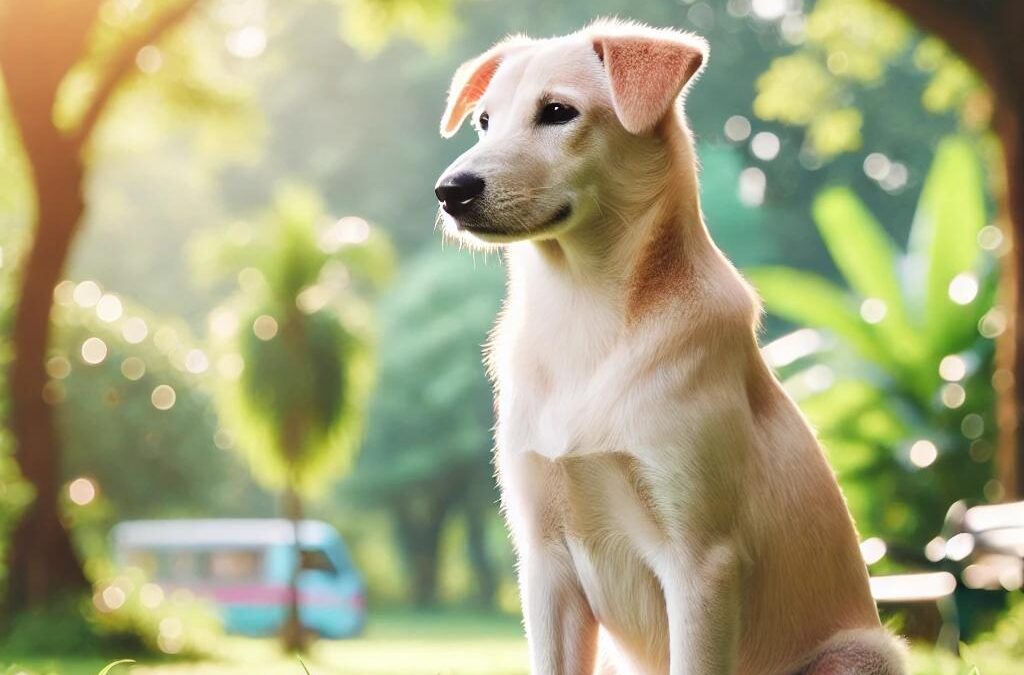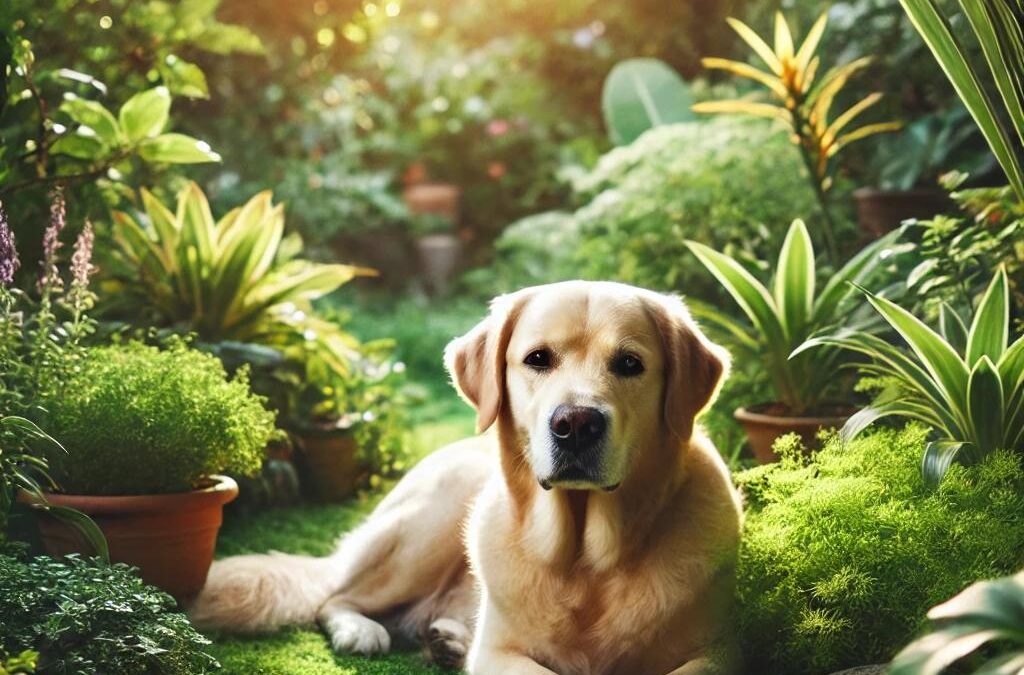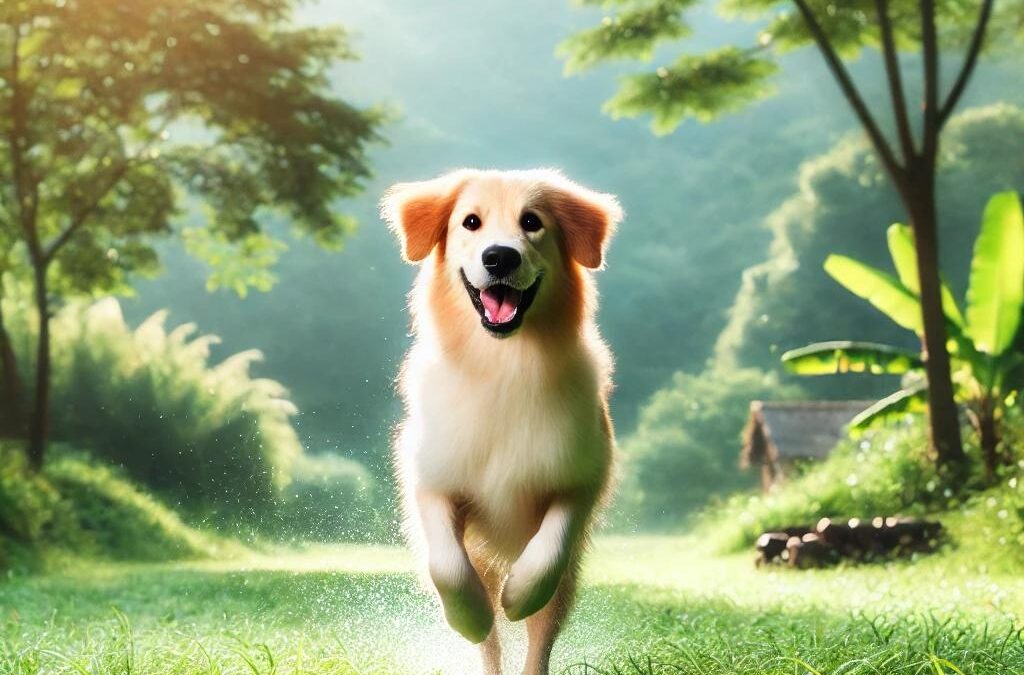
by TCMVET | Sep 18, 2024 | Dog Cancer & Tumors
In recent years, the connection between gut health and overall well-being has become a topic of great interest, not only for humans but also for our pets. The gut microbiome—the complex community of bacteria living in the digestive tract—plays a significant role in various aspects of health, including immunity, digestion, and even cancer risk. In this article, we’ll explore the link between your dog’s gut bacteria and cancer, and how maintaining a healthy microbiome can potentially reduce cancer risk.
Understanding the Gut Microbiome in Dogs
The gut microbiome consists of trillions of microorganisms, including bacteria, fungi, and viruses, that live in the gastrointestinal tract of animals. In dogs, these microbes help break down food, produce essential nutrients, and support the immune system. A balanced microbiome is crucial for your dog’s overall health, as it helps prevent inflammation and protects against diseases, including cancer.
The Gut-Cancer Connection
Researchers have discovered that the gut microbiome has a profound impact on cancer development and progression. Here’s how gut bacteria may influence cancer risk in dogs:
- Immune System Regulation: The gut microbiome plays a critical role in regulating the immune system. A healthy, balanced microbiome promotes a strong immune response, which can detect and destroy cancer cells early. On the other hand, an imbalanced microbiome (dysbiosis) can weaken the immune system, making it harder for the body to fight off cancerous cells.
- Chronic Inflammation: An unhealthy gut microbiome can lead to chronic inflammation in the body, which is a known risk factor for cancer. Inflammation causes cells to become damaged, and over time, this can result in mutations and the formation of tumors.
- Toxin Production: Some harmful bacteria in the gut produce toxins that can damage DNA and promote cancer development. Keeping the gut microbiome in balance can help prevent the overgrowth of these harmful bacteria.
- Impact on Cancer Treatments: Recent studies suggest that the gut microbiome may influence how well cancer treatments, such as chemotherapy and immunotherapy, work. A healthy microbiome may improve treatment outcomes, while an imbalanced one may reduce the effectiveness of these therapies.
Signs of an Unhealthy Gut in Dogs
It’s essential to monitor your dog’s gut health to ensure their microbiome is functioning correctly. Signs of an unhealthy gut include:
- Digestive issues: Diarrhea, constipation, bloating, and excessive gas can indicate an imbalance in the gut bacteria.
- Skin problems: Chronic itching, inflammation, and infections may be related to poor gut health.
- Weakened immune system: Frequent infections or a slow recovery from illness can be signs that your dog’s gut microbiome isn’t supporting their immune function.
- Behavioral changes: Some dogs with gut imbalances may become more anxious, lethargic, or display behavioral changes due to discomfort.
How to Support Your Dog’s Gut Health
Supporting your dog’s gut health is crucial for their overall well-being and may help reduce their cancer risk. Here are some ways to maintain a healthy microbiome in dogs:
- Probiotics and Prebiotics: These supplements can help maintain the balance of beneficial bacteria in your dog’s gut. Probiotics introduce good bacteria, while prebiotics serve as food for these bacteria, promoting their growth.
- High-Quality Diet: A balanced, high-quality diet rich in fiber, vitamins, and minerals can support gut health. Avoid processed foods and focus on whole, nutrient-dense ingredients to nourish your dog’s microbiome.
- Avoid Overuse of Antibiotics: While antibiotics are sometimes necessary, overuse can kill off beneficial bacteria in the gut, leading to dysbiosis. Only use antibiotics when prescribed by your veterinarian and discuss alternatives when possible.
- Regular Exercise: Physical activity can promote healthy gut bacteria and improve digestion. Make sure your dog gets regular exercise to keep their gut functioning optimally.
- Stress Management: Just like humans, dogs experience stress, which can negatively impact their gut health. Providing a calm environment, routine, and mental stimulation can help keep your dog’s gut bacteria in balance.
Can Gut Health Prevent Cancer in Dogs?
While no single factor can completely prevent cancer, maintaining a healthy gut microbiome may reduce your dog’s risk of developing cancer. By supporting your dog’s immune system, reducing chronic inflammation, and keeping harmful bacteria in check, a balanced microbiome can play a key role in protecting your dog from cancer.
The connection between your dog’s gut bacteria and cancer risk is an emerging area of research that highlights the importance of gut health in disease prevention. By focusing on maintaining a balanced gut microbiome, you can help support your dog’s overall health and potentially reduce their risk of cancer. Remember to consult your veterinarian before making any changes to your dog’s diet or health regimen to ensure their specific needs are met.

by TCMVET | Sep 18, 2024 | Dog Cancer & Tumors
Dog tumors, especially those found on the leg, are a common concern for many pet owners. These growths can range from benign (non-cancerous) to malignant (cancerous) and may vary in size, appearance, and behavior. Understanding the causes, symptoms, and treatment options for tumors on a dog’s leg is crucial for ensuring timely care and management. In this article, we’ll explore what you need to know about tumors on a dog’s leg and how to address them effectively.
What Causes Tumors on a Dog’s Leg?
Tumors on a dog’s leg can be caused by various factors, including:
- Genetics: Certain dog breeds are predisposed to developing tumors, such as Boxers, Bulldogs, and Golden Retrievers.
- Age: Older dogs are more likely to develop tumors as their cells are more prone to mutations over time.
- Environmental factors: Prolonged exposure to toxins, radiation, or chemicals can increase the risk of tumor formation.
- Infections and inflammation: Chronic infections or inflammation in the leg area may lead to the development of tumors.
- Immune system issues: A weakened or compromised immune system can lead to abnormal cell growth.
Types of Tumors Found on a Dog’s Leg
There are several types of tumors that can appear on a dog’s leg, including:
- Lipomas: These are benign, fatty tumors that often grow slowly and are soft to the touch. While they are not cancerous, they can become large and uncomfortable.
- Mast cell tumors: One of the most common skin cancers in dogs, mast cell tumors can appear on the leg and may vary in severity. They require immediate veterinary attention.
- Osteosarcoma: A type of bone cancer, osteosarcoma can affect the leg bones, leading to swelling, pain, and lameness.
- Fibrosarcoma: This is a malignant tumor of the connective tissue, which can develop on the leg and may infiltrate surrounding tissues.
- Histiocytomas: These are benign tumors commonly found in younger dogs. They often resolve on their own but may need removal if they grow large or cause discomfort.
Symptoms of Dog Tumors on the Leg
Detecting a tumor on your dog’s leg early can make a significant difference in treatment outcomes. Here are the signs to look for:
- Lumps or masses: Any noticeable lump or swelling on the leg should be examined by a vet, especially if it grows rapidly.
- Lameness: A tumor that affects the bones or joints may cause your dog to limp or have difficulty walking.
- Pain or sensitivity: Tumors, especially cancerous ones, can cause pain and discomfort when touched.
- Changes in skin: The skin over the tumor may become discolored, ulcerated, or show signs of inflammation.
- Loss of appetite or lethargy: In some cases, the presence of a tumor may cause a general decline in your dog’s health.
Diagnosis and Veterinary Examination
If you notice a lump on your dog’s leg, it’s essential to consult your vet for a proper diagnosis. Your vet may perform several tests, including:
- Physical examination: The vet will inspect the size, shape, and location of the tumor.
- Fine needle aspiration (FNA): This involves extracting a small sample of cells from the tumor to analyze whether it is benign or malignant.
- Biopsy: In some cases, a biopsy is required to get a more detailed understanding of the tumor type.
- X-rays or ultrasound: These imaging techniques help assess the depth and spread of the tumor, especially if it involves the bones.
- Blood tests: These may be used to determine if the cancer has spread or if there are underlying health conditions.
Treatment Options for Dog Tumors on the Leg
The treatment for a tumor on a dog’s leg depends on the type and stage of the tumor. Common treatment options include:
- Surgery: For many tumors, especially benign ones like lipomas, surgical removal is often the best option. In some cases, amputation of the leg may be necessary, particularly with aggressive cancers like osteosarcoma.
- Chemotherapy: For malignant tumors, chemotherapy may be used alongside surgery to prevent the spread of cancerous cells.
- Radiation therapy: This treatment is often used for tumors that cannot be fully removed through surgery or when the cancer has spread to nearby tissues.
- Cryotherapy: This method involves freezing and destroying small, superficial tumors.
- Holistic approaches: Some pet owners opt for natural treatments, including supplements, herbal remedies, or dietary changes, to support their dog’s overall health.
Long-Term Care and Monitoring
After treatment, it’s essential to monitor your dog closely for any signs of recurrence or complications. Regular veterinary check-ups, a balanced diet, and ensuring a healthy lifestyle can help your dog recover and maintain its quality of life.
A tumor on a dog’s leg can be a frightening discovery, but with proper veterinary care and attention, many dogs go on to live healthy, happy lives. Early detection and prompt treatment are key to improving outcomes, so always monitor your dog for any unusual lumps or changes in behavior. If you suspect your dog has a tumor, contact your vet as soon as possible for an accurate diagnosis and personalized treatment plan.

by TCMVET | Sep 18, 2024 | Dog Cancer & Tumors
When a dog develops a tumor, especially one like a mast cell tumor, it’s a concerning situation. If the tumor bursts open, the level of worry intensifies. Knowing how to manage an open tumor on your dog can make a significant difference in their health and comfort. This article will guide you through the steps you should take and provide important insights on caring for a dog with an open tumor.
Why Do Dog Tumors Burst Open?
Tumors in dogs, particularly certain types like mast cell tumors, can become large and ulcerated. These tumors have fragile blood vessels and may burst due to trauma, pressure, or natural breakdown of the tissue. A burst tumor is not only distressing to witness, but it also poses a risk of infection and requires immediate attention.
Signs of a Burst Tumor
If your dog has a tumor, you should regularly inspect it for signs of rupture. Here are the symptoms to watch for:
- Open wound: The skin may split, revealing the underlying tissue.
- Bleeding: There could be significant bleeding or oozing of blood and other fluids.
- Foul odor: Infected wounds often emit a strong, unpleasant smell.
- Pain and discomfort: Your dog may lick, scratch, or appear uncomfortable around the tumor site.
- Swelling or inflammation: The area around the tumor might swell, become red, or inflamed.
Immediate Steps to Take
If your dog’s tumor bursts, it is important to act quickly. Here are the steps to take:
- Stay calm: Your dog will sense your anxiety, so it’s important to stay composed.
- Clean the wound: Use a saline solution or clean water to gently rinse the wound and remove dirt or debris. Avoid using harsh chemicals unless directed by a vet.
- Apply pressure: If there is active bleeding, apply gentle pressure with a clean cloth or gauze until it slows.
- Use a bandage: After cleaning the wound, you can loosely cover it with sterile gauze to protect it from further contamination. Ensure the bandage isn’t too tight.
- Seek veterinary care: An open tumor requires professional attention. Your vet may need to clean the wound further, prescribe antibiotics to prevent infection, and suggest pain management options.
Long-Term Care for Dogs with Open Tumors
Once the immediate situation is under control, long-term care is essential. Your vet will guide you through the proper steps, but here are some general tips:
- Wound care: Keep the area clean and change bandages as directed by your vet. You may need to use medicated ointments to promote healing and prevent infection.
- Pain management: Ensure your dog is comfortable by following the prescribed pain relief plan.
- Monitor for infection: Signs of infection include increased redness, swelling, pus, or a worsening smell. If you notice any of these, contact your vet immediately.
- Surgical intervention: In some cases, surgery may be recommended to remove the tumor entirely or to clean the wound.
Preventing Further Tumor Complications
To prevent further issues with your dog’s tumors, regular veterinary checkups are critical. Early detection and intervention can prevent tumors from reaching a stage where they might burst. In some cases, tumors can be surgically removed before they become problematic. Additionally, discussing treatment options like chemotherapy or radiation with your vet can help manage the progression of certain cancerous tumors.
A dog’s tumor bursting open is a serious situation that requires immediate attention. By following the proper steps and consulting with your vet, you can manage the situation and help ensure your dog’s comfort and safety. Regular checkups and prompt treatment are the best ways to prevent further complications and give your dog the best chance at a healthy life.

by TCMVET | Sep 17, 2024 | Dog Cancer & Tumors
Cancer is one of the leading causes of death in dogs, and while conventional treatments such as surgery, chemotherapy, and radiation are often used, many pet owners are exploring natural remedies to complement these therapies. Natural remedies can offer supportive care, helping to manage symptoms, boost the immune system, and improve the overall quality of life for dogs battling cancer. In this article, we explore various natural remedies and how they may benefit dogs with cancer.
How Can Natural Remedies Help Dogs with Cancer?
While natural remedies are not a cure for cancer, they can play a significant role in supporting conventional cancer treatments. They may help to alleviate side effects, reduce inflammation, improve appetite, and strengthen the immune system. When used alongside veterinary care, natural remedies can help dogs cope better with their condition and treatments.
Key Natural Remedies for Dogs with Cancer
Here are some of the most commonly used natural remedies for dogs with cancer:
1. Herbal Supplements
Herbal remedies have been used for centuries in traditional medicine and can offer valuable support for dogs with cancer.
- Turmeric (Curcumin): Known for its anti-inflammatory and antioxidant properties, turmeric is widely used as a natural remedy for cancer. Curcumin, the active ingredient, has been shown to slow tumor growth and reduce inflammation, making it a helpful addition to cancer treatment plans.
- Milk Thistle: This herb is commonly used to support liver function, which is crucial when a dog is undergoing chemotherapy or taking medication. Milk thistle helps detoxify the liver and may protect it from the harmful effects of drugs used in cancer treatment.
- Astragalus: Astragalus is believed to boost the immune system and has been used in traditional Chinese medicine for centuries. It may help increase a dog’s resistance to infections and support their overall health during cancer treatment.
2. Medicinal Mushrooms
Medicinal mushrooms such as Reishi, Maitake, and Shiitake have been studied for their immune-boosting and anti-cancer properties. These mushrooms contain beta-glucans, which stimulate the immune system and help the body fight cancer more effectively.
- Reishi Mushroom: Known as the “mushroom of immortality,” Reishi has anti-tumor and immune-enhancing effects, making it beneficial for dogs with cancer.
- Maitake Mushroom: Studies have shown that Maitake mushrooms can slow the growth of tumors and enhance the effectiveness of chemotherapy treatments.
3. CBD Oil
Cannabidiol (CBD) is a non-psychoactive compound derived from the hemp plant that has gained popularity for its potential benefits in cancer care for dogs. CBD oil may help:
- Pain management: CBD is known for its pain-relieving properties and can help dogs cope with cancer-related discomfort and pain caused by treatments.
- Reducing inflammation: CBD has anti-inflammatory properties that can alleviate swelling and discomfort associated with tumors.
- Improving appetite: Cancer treatments often reduce a dog’s appetite, leading to weight loss. CBD oil can help stimulate appetite and improve nutritional intake.
4. Omega-3 Fatty Acids
Omega-3 fatty acids, found in fish oil and flaxseed oil, have powerful anti-inflammatory properties and may help slow the growth of cancer cells. These healthy fats support immune function and are beneficial in reducing the inflammation that often accompanies cancer.
- Fish oil: Rich in EPA and DHA, fish oil can reduce inflammation and improve the overall health of dogs undergoing cancer treatment. It may also help protect healthy cells from the damaging effects of cancer therapies.
5. Dietary Adjustments
Proper nutrition plays a key role in supporting dogs with cancer. Many veterinarians recommend switching to a high-protein, low-carbohydrate diet to help “starve” cancer cells, as cancer tends to thrive on sugar.
- High-quality protein sources: Provide lean meats such as chicken, turkey, and fish to help maintain muscle mass and energy levels.
- Anti-cancer vegetables: Vegetables like broccoli, spinach, and sweet potatoes are rich in antioxidants and vitamins that support immune health.
6. Acupuncture and Massage Therapy
Alternative therapies such as acupuncture and massage can complement cancer treatments by providing pain relief, reducing stress, and improving circulation.
- Acupuncture: This traditional Chinese medicine technique involves inserting thin needles into specific points on the body to stimulate healing and relieve pain. Acupuncture can help manage symptoms such as nausea, fatigue, and pain in dogs with cancer.
- Massage therapy: Gentle massage can improve circulation, relieve muscle tension, and reduce stress in dogs undergoing cancer treatment. It can also promote relaxation and emotional well-being.
Benefits of Natural Remedies for Dogs with Cancer
Natural remedies can offer several benefits when used in conjunction with traditional cancer treatments. Some of the key benefits include:
- Pain relief: Many natural remedies, such as CBD oil and acupuncture, help relieve cancer-related pain, improving the dog’s comfort and quality of life.
- Reduced inflammation: Herbs like turmeric and omega-3 fatty acids have anti-inflammatory effects, which may help slow cancer progression and reduce tumor-related swelling.
- Boosted immune system: Medicinal mushrooms and herbs like astragalus can strengthen the immune system, helping the dog’s body fight cancer more effectively.
- Improved appetite and digestion: CBD oil and certain dietary changes can stimulate appetite and improve digestion, ensuring the dog receives the nutrients it needs to maintain strength during treatment.
Precautions When Using Natural Remedies
While natural remedies can offer support, it is important to consult with a veterinarian before introducing any new supplements or therapies. Some natural remedies may interact with conventional cancer treatments or may not be suitable for all dogs, depending on their condition. Always follow professional guidance to ensure your dog’s safety and well-being.
Natural remedies can provide valuable support for dogs with cancer, helping to manage symptoms, improve comfort, and enhance overall well-being. From herbal supplements and medicinal mushrooms to CBD oil and dietary changes, these holistic approaches can complement conventional cancer treatments, offering a more comprehensive care plan for dogs. As always, consult your veterinarian before implementing any new remedies to ensure they are safe and effective for your dog’s unique needs.

by TCMVET | Sep 17, 2024 | Dog Cancer & Tumors
Pollution is an increasing concern for both humans and animals, and recent research shows that it can play a significant role in the development of cancer in dogs. As our environment becomes more contaminated by chemicals, pesticides, and air pollutants, dogs are being exposed to harmful substances that may contribute to the rise of cancer cases among pets. Understanding how pollution affects our canine companions and taking preventive measures can help reduce the risk of cancer and other health problems in dogs.
How Pollution Affects Dogs
Dogs are exposed to environmental toxins in many ways, from the air they breathe to the surfaces they walk on and even the food they eat. Their close contact with the ground and their natural behaviors, such as licking and sniffing, make them particularly vulnerable to pollutants.
Common Sources of Pollution for Dogs:
- Air Pollution: Dogs living in urban areas are constantly exposed to smog, industrial chemicals, and car emissions. Just like humans, dogs can inhale these airborne toxins, which may cause respiratory problems and increase the risk of cancers, particularly lung and nasal tumors.
- Pesticides and Herbicides: Pesticides used in lawns, parks, and public areas are one of the most common sources of toxic exposure for dogs. When they walk on chemically treated grass or play in gardens sprayed with pesticides, these substances can be absorbed through their paws or ingested when they lick themselves.
- Water Contamination: Polluted water sources, including lakes, rivers, and even tap water, can expose dogs to harmful chemicals like lead, arsenic, and industrial waste. Drinking contaminated water over time can lead to a buildup of these toxins in their bodies, increasing the risk of cancer and other health issues.
- Household Chemicals: Many household products, including cleaning agents, paints, and insecticides, contain toxic ingredients that can affect dogs. Long-term exposure to these chemicals, especially in poorly ventilated homes, can contribute to the development of cancers, such as lymphoma and bladder cancer.
Types of Cancer Linked to Pollution
While cancer in dogs can result from genetic factors, environmental toxins also play a crucial role in many cases. Here are some types of cancers that have been linked to pollution in dogs:
1. Lung Cancer
Lung cancer in dogs can be caused by prolonged exposure to air pollution, cigarette smoke, and industrial pollutants. Dogs living in urban areas with poor air quality are at a higher risk of developing lung cancer due to continuous inhalation of harmful particles and chemicals.
2. Lymphoma
Lymphoma is one of the most common cancers in dogs and is often associated with exposure to pesticides, herbicides, and other chemicals. Studies have shown that dogs living in homes or neighborhoods where lawns are frequently treated with pesticides are more likely to develop lymphoma.
3. Bladder Cancer
Certain chemicals found in herbicides and insecticides have been linked to bladder cancer in dogs. Dogs that are frequently exposed to treated lawns or live near areas where these chemicals are heavily used may be at a higher risk.
4. Nasal Cancer
Nasal cancer in dogs has been linked to long-term exposure to secondhand smoke, smog, and industrial pollutants. Dogs with long noses (dolichocephalic breeds) are particularly susceptible to developing nasal tumors when exposed to airborne toxins.
5. Mammary and Skin Cancers
Pollutants in the environment, such as UV radiation from the sun combined with chemical exposure from cleaning agents and pesticides, can increase the risk of mammary and skin cancers in dogs.
Steps to Protect Your Dog from Pollution
While you can’t completely shield your dog from environmental pollutants, there are several steps you can take to minimize their exposure and reduce the risk of cancer.
1. Limit Exposure to Air Pollution
- Avoid walking your dog during high-traffic hours or in areas with heavy industrial activity.
- Keep windows closed on days with poor air quality and use air purifiers at home to reduce indoor pollution.
- If you are a smoker, avoid smoking near your dog to prevent exposure to secondhand smoke.
2. Choose Natural Lawn Care
- Opt for organic or pet-safe lawn care products that do not contain harmful pesticides or herbicides.
- Avoid letting your dog walk on freshly treated lawns or play in areas where chemicals have been recently applied.
3. Provide Clean Drinking Water
- Use filtered water for your dog’s drinking water to remove potential contaminants like heavy metals and chemicals.
- If your dog swims in lakes or rivers, make sure these water sources are clean and free of pollutants.
4. Use Non-Toxic Cleaning Products
- Choose pet-safe, non-toxic cleaning products for your home. Many green or eco-friendly products are formulated without harmful chemicals that could pose a risk to your dog’s health.
- Ensure that your dog is not present when using strong chemicals or during painting or renovation projects.
5. Regular Veterinary Check-ups
- Routine vet visits are crucial for early detection of any health issues, including cancer. Discuss any concerns about your dog’s environment with your vet to ensure that they are screened for potential exposure-related risks.
- Ask your vet about cancer-preventive measures, such as supplements or dietary changes, to help boost your dog’s immune system and overall health.
Pollution is an unavoidable part of modern life, but understanding the risks it poses to dogs and taking proactive steps can help reduce the chances of pollution-related cancers. By limiting your dog’s exposure to harmful chemicals in the air, water, and environment, you can contribute to their long-term health and well-being. Regular veterinary care, combined with careful attention to your dog’s surroundings, can play a vital role in preventing cancer and other serious health issues caused by pollution.





